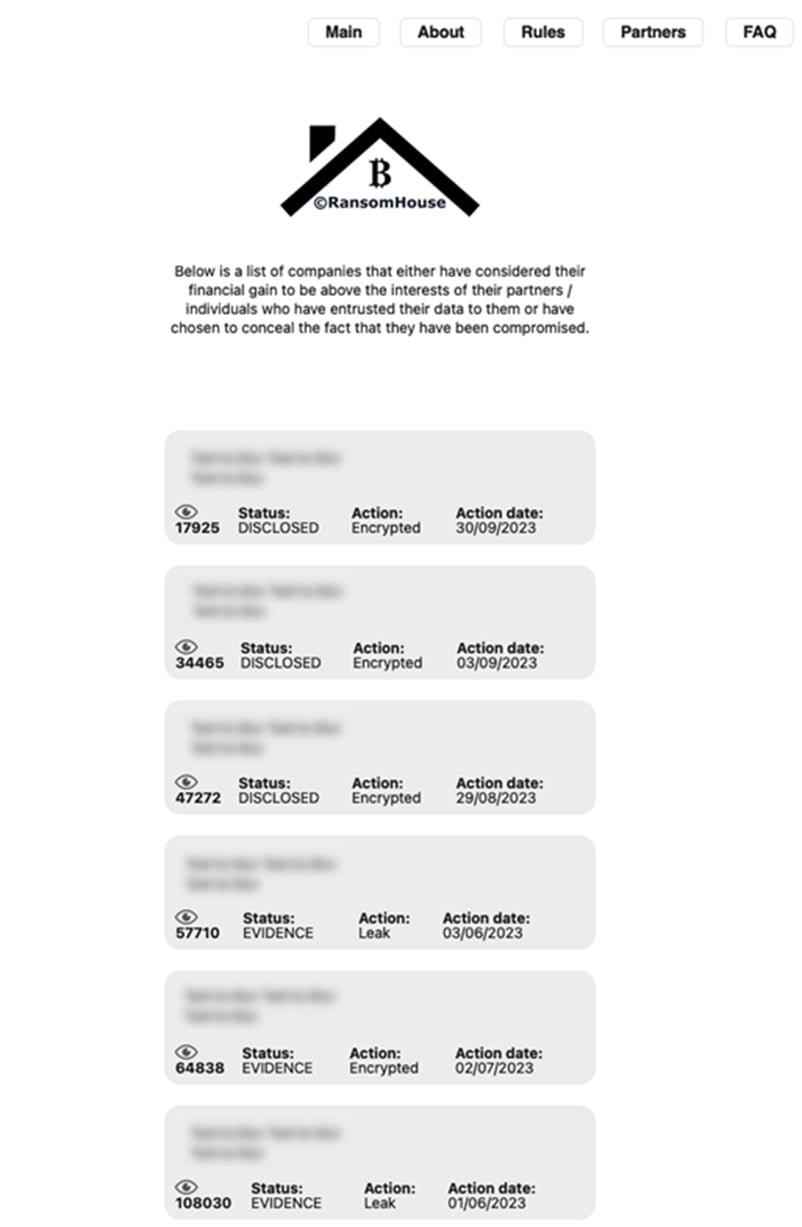Double Trouble: RansomHouse’s Extortion Tactics Revealed

The RansomHouse ransomware group exemplifies the sophisticated, profitable, and adaptable nature of modern cyber extortion campaigns. Emerging in late 2021, their operations blend technical efficiency with psychological pressure, maximizing their potential takings. RansomHouse’s double extortion model involves both encrypting victim data for ransom and the threat of public shaming and data leaks via their dedicated blog. Recently, two security researchers Pham Duy Phuc and Max Kersten from Trellix, along with Noël Keijzer and Michaël Schrijver from Northwave, provided an overview of the ransomware group behind it, RansomHouse.

Censored screenshot of the RansomHouse victim leak page | Image: Trellix
RansomHouse Tactics
- Technical Prowess: The group leverages techniques like content delivery networks (CDNs) for data exfiltration and Tor-based chat rooms for ransom negotiations, demonstrating their understanding of secure communications.
- The Illusion of Professionalism: RansomHouse cultivates a professional demeanor within its negotiation platforms and communications. This veneer of legitimacy contrasts with their ruthlessness when exploiting victims and attempts to increase pressure for payment.
- Double the Impact: RansomHouse’s double extortion model, frequent countdown timers during negotiations, and the analysis of a live negotiation demonstrate the severe pressure victims experience, a strategy designed to expedite payment.
A RansomHouse Negotiation Case Study
An in-depth look at a RansomHouse negotiation reveals their well-practiced playbook:
- The Initial Breach: Entry points are frequently vulnerabilities in CITRIX remote access or VMware ESXi systems. Weak security practices provide easy initial access.
- Escalating Privileges: After gaining an initial foothold, attackers exploit weak systems, compromised user accounts, and domain-wide vulnerabilities to establish control over the victim’s network.
- “Helpful” Advice: Ironically, RansomHouse often suggests security improvements to avoid future attacks, highlighting their deep understanding of the vulnerabilities they exploit – and their willingness to re-victimize organizations that do not take corrective action.
Additional Insights from the Negotiation:
- Staggering Data Theft: File transfers to external storage services, like the MEGA example, illustrate the massive scale of data exfiltration in many RansomHouse cases.
- Ransom Flexibility: RansomHouse often settles for less than the initial demand. This strategy ensures consistently large payouts while minimizing the risk of the victim walking away.
- Money Laundering: Blockchain analysis of payment flows reveals intricate Bitcoin transfers designed to obscure the cybercriminal’s identities and the movement of stolen funds.
The Evolving Threat & Rise of MrAgent
RansomHouse continues to refine its approach, as evidenced by the MrAgent tool, specifically designed to automate large-scale ransomware deployment against VMware ESXi systems. Their targeting preferences paint a clear picture:
- No Borders: The significant spike in attacks against United States and Western European entities underscores the global scope of their operation.
- Industry Preference: The Industrials and Technology sectors suffer disproportionate attacks, likely due to their reliance on sensitive data and their complex digital infrastructure.
- Shifting Targets: While still targeting large enterprises, RansomHouse increasingly aims at mid-sized companies, perceived as having accessible resources but often weaker security protocols.
Essential Defenses Against RansomHouse (and Others)
While RansomHouse is a particularly dangerous threat, the following strategies offer broad protection against ransomware groups:
- Patching is Paramount: Apply security patches promptly across all software, especially internet-facing technologies.
- Zero Trust Principles: Implement a Zero Trust architecture that limits user access and lateral movement within networks to mitigate an attacker’s ability to spread widely after a breach.
- Backup as a Lifesaver: Regularly maintained, secure, and off-site backups can be invaluable in recovering after a ransomware attack.
- Employee Awareness: Educate all staff on phishing and social engineering tactics to help identify and prevent the initial attacks.
- Consider Incident Response Planning: Proactively establish an incident response plan that includes clear roles, communication procedures, and the identification of external cybersecurity partners to call on in the event of a breach.





